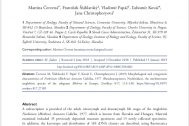Content
A redescription is provided of the adult, tritonymph and deutonymph life stages of the troglobitic Neobisium (Blothrus) slovacum Gulička, 1977, which is known from Slovakia and Hungary. Material examined included 35 previously deposited museum specimens and 15 newly collected specimens. In addition, the karyotype and distribution of 18S rDNA clusters are described, using fluorescence in situ hybridization (FISH). The male karyotype of N. slovacum comprises 69 chromosomes, with a predominance of biarmed chromosomes, and an X0 sex chromosome system. Two pairs of signals for 18S rDNA on biarmed chromosomes (submetacentric and metacentric) of different sizes were identified. The present study provides the first information about the distribution of these clusters in the arachnid order Pseudoscorpiones. The geographic distribution of the species is summarized and mapped. Neobisium slovacum is endemic to the Slovak and Aggtelek Karst area in southern Slovakia and north-western Hungary, where it has been recorded from 16 caves. One of these, Hačavská cave (in Slovakia), is the
northernmost locality known for any species of the subgenus Blothrus.
northernmost locality known for any species of the subgenus Blothrus.



